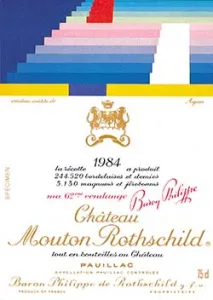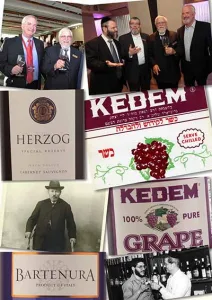Biblical Heritage
The art of winemaking is thought to have begun somewhere in the triangle between the Black Sea, the Caspian Sea and the Sea of Galilee. From there the vine travelled south through Phoenicia and Canaan to Egypt, which became the first great wine culture. The Egyptians particularly prized the wine of Canaan. So Canaan must have been one of the earliest countries to make wine – and this was over 2,000 years before the vine reached Europe.
The Israelites’ interest in winegrowing is a continual theme throughout the Bible and Talmud. Wine was seen as a symbol of happiness and out of all the books of the Bible, only the Book of Jonah contains no reference to it.
Of the seven species with which Eretz Israel was blessed, the vine was first amongst the fruits (Deut. 8:8).
The first mention of wine in the Bible is Noah, who built the ark to prepare for the flood. After the water subsided, he planted a vineyard and then got drunk on the resulting wine. (Genesis 9:20-21).
When in the Book of Numbers, Moses sent the spies to scout out the ‘Promised Land’, they returned with a bunch of grapes, so large that it had to be carried on a pole, to illustrate that ‘this was a land flowing with milk and honey’. This image has been used today as the logo of both Carmel Winery and the Israel Government Tourist Office.
Isaiah’s song about vineyards (Isa. 5) gives a detailed account of planting a vineyard through to the harvesting of its grapes. He likens God to an owner of a vineyard and Israel to the vineyard. Ezekiel (17:1-10; 19:10-14) also regards the vine as symbolizing the people of Israel and all the prophets use vines as a symbol of the happy state. The prophet Michah’s vision of peace on earth was “… every man shall sit under his vine and fig tree and none shall make him afraid.”
Sixteen times the Bible mentions corn, wine and oil as representing the principle produce of the country, the base of the economy and chief blessing of the soil (Deut. 7:13).
The trilogy of wine, oil and bread is again mentioned in Psalm 104, which praises God for providing for his people:
He causes the grass to grow for the cattle,
and herb for the service of man
that he may bring forth food out of the earth
And wine that gladdens the heart of man
And oil to make his face shine
And bread that strengthens man’s heart.
It is a celebration and thanksgiving of what were considered the staples of a healthy life: meat, milk, plants, wine , olive oil and bread.
There is no quality wine producing country in the present day that can boast such a rich history of wine production and wine culture as Israel. Almost everywhere, archeological finds have been unearthed in abundance. Coins, amphorae, wine presses, wine goblets all bear witness to a wine history, which continued unbroken until the Moslem conquest in 636 C.E.
Wine in Ancient Times
Many wine presses have been discovered throughout Israel, giving a guide as to the winemaking practices more than 2,000 years ago. Visit any modern winery in Israel and they will show you the ancient wine press nearby. In the Ha’aretz Museum in Tel Aviv, they have a number of different wine presses from different periods to illustrate how they changed and developed over the years.
Grapes were crushed underfoot in a shallow, limestone basin. Fermentation was natural and immediate. The wine went through a couple of rudimentary filtration channels, where twigs with thorns were placed to trap stems and skins and then the wine were transported in new goat skins, which were ideal because they could expand if there was any secondary or continuing fermentation. They were then left to age in the pottery amphorae, often in cool, dark caves.
Most of the wines were either red or a mixture of red and white grapes, resulting in a muddy brown color. Many were flavored with honey or raisons to make them sweet or herbs and spices like cardamom and saffron to make them palatable. There was a large consumption of wine, far greater than today, because it was safer than the water.
However wine was not just for drinking but also for medical purposes, for cleaning out homes and for dyeing cloth
There was a very advanced wine trade. Different amphorae were exported with an inscription stating where the wine had come from. The vineyards of Galilee and Judea were especially prized as were wines with names like Sharon, Carmel, Gaza, Ashkelon and Lod. The most exciting recent find was two wrecked Phoenician ships found off the coast of Israel. Their cargo was wine contained ceramic amphorae most likely being exported to Egypt.
Religious Connection
To Jews there is no communal, religious or family life without wine. Each Sabbath starts with an act of blessing, the Kiddush or “Sanctification” is chanted over a cup of wine: “Blessed are you O Lord, Our God……for creating the fruit of the vine.” Most Jewish families will own a “Kiddush Cup” in the form of a silver goblet or beaker. Four glasses of wine must be drunk at Passover (or grape juice for children), two at weddings, one at circumcisions. At a funeral in ancient times a bereaved was offered ten glasses of wine, the “Cup of Consolation”. Wine is used to sanctify festivals, Bar Mitzvahs and births. At the Festival of Purim, Jews are entreated to drink enough so they are unable to tell the difference between “Cursed be Haman” and “Blessed be Mordechai”. Traditionally a Jewish boy will have his first taste of wine at his circumcision when only eight days old, and part of a ritual at a wedding is for the groom to stamp on and shatter a wine glass. The joy of wine is introduced to each act of worship.
For the Kiddush ceremony in the Jewish home and in synagogues, sweet red (and usually fortified) wine is traditionally used for two reasons: one, as an open bottle will last until the next week, and two, for children a sip of sweet wine is both palatable and a treat!
The association between wine, Israel and Judaism creates an unique bond between wine and the Jewish people. Also the Christian use of Altar or Communion wine, stemmed not only from the Jewish faith but also from the high profile of wine in the Holy Land at this time. The Last Supper was nothing more than the Jewish Passover meal. The positive imagery of wine continued in the New Testament. When Jesus changed the water into wine at the wedding feast at Cana in Galilee, they were not to know that 2,000 later, that the Galilee would be producing some of Israel’s finest wine.
Wine writer Andrew Jefford wrote in the Evening Standard Wine Guide: “The Land of Israel staggers beneath its burden of history and myth, and much of that intoxicating scripturally sanctified baggage is wine-sodden. What Christian would not like to drink the wine of Cana or Galilee after a thoughtful afternoon amongst the splintery, fissured olives of Gethsemane. What Jew would prefer a French kosher wine to one from the land which (according to the Book of Numbers) Moses’ spies returned bearing an enormous cluster of grapes suspended from a pole”
Adam Montefiore works for Carmel Winery and regularly writes about wine in both Israeli and international publications.

















